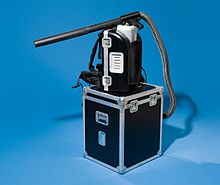Artificial snow that does not melt
Non-melting artificial snow based on paper , starch or plastic is used in film and advertising productions as well as for recordings in photo studios .
For film productions there are service providers who snow in entire landscapes or districts with special machines. For the falling snow in front of the camera, blowers are available that blow light paper flakes into the air. Due to its consistency, the artificial snow cannot be distinguished from natural snow in the finished film.
In the field of display advertising design, one speaks mainly of decorative snow.
Types of artificial snow
Display Snow, flame retardant
This artificial snow is made on a plastic basis ( LDPE ), is antistatic and has a B1 fire classification. The Display Snow is made in different flake sizes for different uses. The grain size of 10 to 20 mm is particularly suitable as falling snow. The grain size of 5 to 15 mm can also be used for falling snow effects or as coarse lying snow. This is also used as lying snow with a grain size of 3 to 10 mm. A grain size of 1 to 5 mm is suitable for imitating powder snow .
Glittering snow, inhibiting flames
The glitter snow is made of fine polystyrene and gives the lying snow a more realistic effect, as it is thinly scattered over a snow surface. This creates a natural glitter effect like freshly fallen snow.
Magic Snow
This snow is mixed with water and swells up. Various effects, such as: B. fresh snow , powder snow or slush can be achieved. This snow is particularly productive.
Organic snow
This snow is made from corn starch and plant extracts and is therefore completely biodegradable. When using it, make sure that the snow does not come into contact with water, otherwise it will stick together. The organic snow is mainly used as lying snow.
Film snow, SnowCel Movie Snow HSX
This is the snow most used in the film business worldwide. This paper-based artificial snow is used as lying snow. Due to its natural structure, footprints or tire tracks can be reproduced in the snow.
Colored artificial snow
To simulate z. B. volcanic ash there is black and gray colored plastic-based snow. This is suitable as falling and lying snow.
Areas of application
Cinema and TV productions
For film productions where no real snow is available, landscapes and streets are covered with artificial snow. Even at temperatures in the double-digit range, optimal winter scenes can be filmed. Falling artificial snow is mainly used in film productions. This can be used to simulate light falling flakes or snowstorms.
Events
The artificial snow is also suitable for use at events. In this way, the event locations can be transformed into a wintry ambience. The artificial snow is mainly used at Christmas parties and Christmas markets.
decoration
In some areas of the retail trade, the Christmas business starts as early as September. In the sales or shop window area, winter effects can be achieved with the non-melting artificial snow.
Chemical compositions
- Paper snow is made from high-purity cellulose .
- Magic snow is a copolymer based on sodium acrylate .
- Snow fluid (for falling snow effects) is a water-like mixture of less than 5% biodegradable anionic / nonionic surfactants with less than 2% unclassified glycol ether with a trace of preservative.
- Organic snow can be made from corn starch.
- Snow carpet is made of polypropylene .
See also
- Plastic jumps for ski jumping without snow.
- Snow globe
Individual evidence
- ↑ Film productions with artificial snow (PDF; 490 kB). Westfälische Nachrichten, September 22, 2009. Snowmen in Hollywood use



